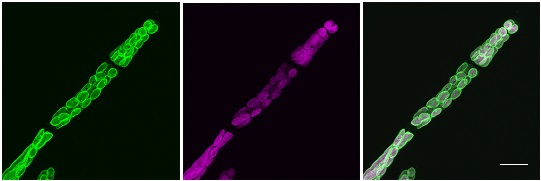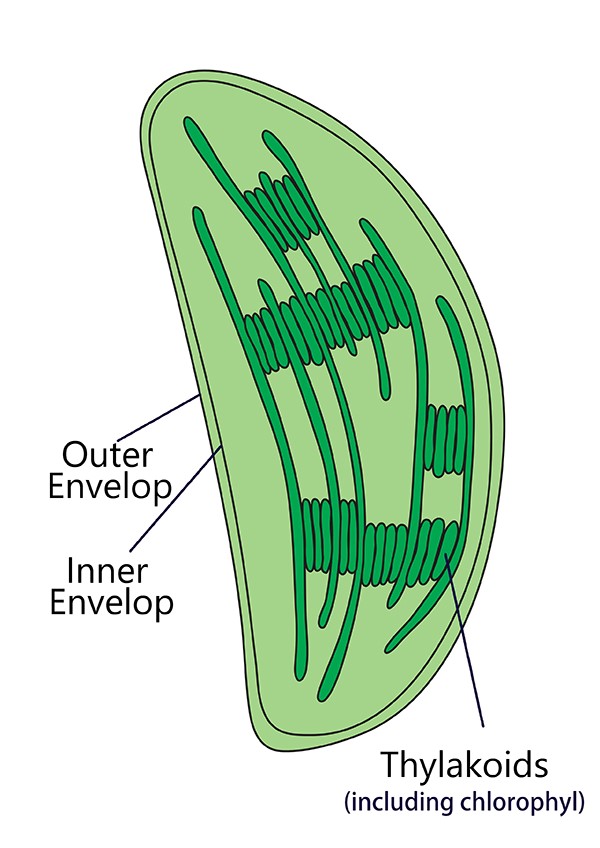Hidden moss chloroplast ‘wall’ discovered
Researchers of Kumamoto University in Japan have succeeded in the world's first visualization of a peptidoglycan “wall” present in the chloroplasts of bryophytes (moss plants). Until now, chloroplasts of green plants were considered to be surrounded only by two envelopes. The results of this research overturns conventional wisdom about the structure of chloroplasts.The chloroplast is a plastid (organelle) that carries out photosynthesis in plant cells. The presently accepted theory of its origin states that a cyanobacterium, which originally had photosynthetic ability, was engulfed by a eukaryotic cell more than 1 billion years ago and eventually became the chloroplast. Chloroplasts, like their cyanobacterium ancestors, proliferate through division.
Cyanobacteria have a peptidoglycan layer component in their cell walls, but this layer has never been observed in the chloroplasts of green plants. Until recently, it was thought that the chloroplast had lost this layer over its evolution. However, two separate research groups, Freiburg University, Germany in 1997 and Kumamoto University in 2002 and 2003, showed that some plants which were thought to have lost the peptidoglycan layer react to antibiotics with inhibited chloroplast division. Furthermore, the findings from Kumamoto University strongly suggested that antibiotics specifically target peptidoglycan biosynthesis in the moss chloroplast. This caused the Kumamoto University researchers to wonder if a peptidoglycan layer actually existed despite not yet being observed, and so began their investigation.
"We decided to do our analysis using the moss, Physcomitrella patens," said Professor Hiroyoshi Takano of Kumamoto University’s Graduate School of Science and Technology. "We isolated a moss gene which was homologous to a bacterial gene that encodes the enzyme D-alanine: D-alanine ligase (Ddl). This enzyme is responsible for combining 2 D-alanine molecules into the single molecule D-alanyl-D-alanine (D-Ala-D-Ala) whose only purpose within the cell is the biosynthesis of peptidoglycan. Then, we used a gene targeting technique to generate genetically modified plants without that gene."
The researchers found that the size of the chloroplasts of the mutant plants were greatly increased and chloroplast division appeared to be inhibited. They then grew the mutant plants in a medium supplemented with D-Ala-D-Ala which led to a recovery of chloroplast division. This suggested that the moss plant used peptidoglycan in chloroplast division.
Furthermore, the researchers bound a fluorescent molecule to D-Ala-D-Ala and observed the results through a fluorescence microscope. Fluorescent D-Ala-D-Ala surrounding the chloroplast provided visual proof of the existence of the peptidoglycan "wall" around the chloroplast.
"We think that the 'wall' structure of the moss chloroplast is closely involved in both the division and morphology of the chloroplast," said Professor Takano. "The ‘wall’ structure of chloroplasts in green plants had been considered lost during the early days of endosymbiosis. Genomic data shows that this peptidoglycan wall has indeed disappeared in angiosperms, but we have shown for the first time that it remains in a moss plant. Similar to moss, the basal land plants may also use peptidoglycan for chloroplast division. The discovery of this ‘wall’ is an important discovery that rewrites the book on the fundamental structure of the chloroplast."
This finding was posted in "The Plant Cell" on June 20th, 2016.
[Paper Info]
TITLE:
Moss Chloroplasts are Surrounded by a Peptidoglycan Wall Containing D-Amino Acids
AUTHORS:
Takayuki Hirano, Koji Tanidokoro, Yasuhiro Shimizu, Yutaka Kawarabayasi, Toshihisa Ohshima, Momo Sato, Shinji Tadano, Hayato Ishikawa, Susumu Takio, Katsuaki Takechi, and Hiroyoshi Takano
JOURNAL:
The Plant Cell
DOI:
10.1105/tpc.16.00104
URL:
http://www.plantcell.org/content/early/recent

Peptidoglycan surrounding moss chloroplasts
Reconstructed three-dimensional confocal micrographs showing fluorescence in the moss chloroplast caused by (left) the binding of Alexa Fluor 488 to D-Ala-D-Ala revealing a peptidoglycan “wall” and (middle) chlorophyll autofluorescence. The right image is a combination of the left and middle images. (Adapted from Figure 4B of Hirano et al., 2016)

The Chloroplast
The textbook description of the chloroplast shows that it is surrounded by two envelopes. However, recent research by Kumamoto University’s Professor Takano has shown that moss chloroplasts have an extra peptidoglycan “wall.”
Credit: Professor Hiroyoshi Takano
Usage restrictions: This image may only be used in conjunction with the accompanying release, or stories written about the work described in the release with reference to the original work (Hirano et al., 2016).
Credit: Professor Hiroyoshi Takano
Usage restrictions: This image may only be used in conjunction with the accompanying release, or stories written about the work described in the release with reference to the original work (Hirano et al., 2016).
